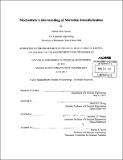Mechanistic understanding of microbial desulfurization
Author(s)
Abín-Fuentes, Andrés
DownloadFull printable version (9.015Mb)
Other Contributors
Massachusetts Institute of Technology. Department of Chemical Engineering.
Advisor
Daniel I.C. Wang and Kristala L.J. Prather.
Terms of use
Metadata
Show full item recordAbstract
The increasing global levels of sulfur content in crude oil have motivated the development of alternate desulfurization technologies. Microbial desulfurization or biodesulfurization (BDS) has gained interest due to the ability of certain biocatalysts to desulfurize compounds that are recalcitrant to the currently employed hydrodesulfurization (HDS) technology. Two of the major obstacles to commercialization of BDS are mass transport limitations and the inability to maintain biocatalyst activity for long periods of time. In this work, the mass transport limitations were studied in a small-scale model system consisting of a resting cell suspension of Rhodococcus erythropolis IGTS8 mixed with hexadecane containing dibenzothiophene (DBT). DBT has become the model compound in BDS studies because its alkyalted derivatives are highly recalcitrant to HDS. Biocatalyst aggregation was found to be significant at cell densities higher than approximately 5 g DCW/L, with aggregates reaching mean diameters of over 100 gm. The diffusion of DBT through the aggregates was the major mass transport limitation in the system. Agitation at a power input per volume of over 10 W/L was estimated to be enough to overcome all mass transport limitations in the BDS system. 2-hydroxybiphenyl retention by the biocatalyst was correlated with the reduction in biocatalyst activity. The biocatalyst affinity for HBP is on par with that of the oil phase and about 60 times that of the aqueous phase. Inhibition of three of the four enzymes in the BDS pathway by HBP was determined to be the cause for the reduction in biocatalyst activity. This conclusion was reached from the finding that the concentrations of HBP that affect the enzymes are significantly lower than the estimated cytoplasmic HBP concentrations during BDS. A mathematical model based on enzyme inhibition predicted the reduction in BDS accurately.
Description
Thesis (Ph. D.)--Massachusetts Institute of Technology, Dept. of Chemical Engineering, 2013. Cataloged from PDF version of thesis. Includes bibliographical references (p. 136-143).
Date issued
2013Department
Massachusetts Institute of Technology. Department of Chemical EngineeringPublisher
Massachusetts Institute of Technology
Keywords
Chemical Engineering.